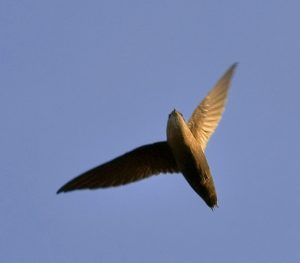Apparently, L&F/Iain Rankin have drawn a line in the sand at Corbett-Dalhousie Lake

Chimney Swift, photo by Jim McCulloch. Chimney Swifts, listed as Threatened in Canada and Endangered in Nova Scotia, have been sighted above the Corbett-Dalhousie Lake forest and may nest there.
I made an inference I apparently shouldn’t have made from the CTV News story I commented on yesterday (Logging at Nova Scotia’s Corbett-Dalhousie Lakes Crown land delayed by company doing the cut to respect Migratory Bird Convention Act 11Jun2019).
In an interview on CBC Information Morning for Halifax this a.m. WestFor’s General Manager Marcus Zwicker said that all across Canada, logging continues though nesting seasons; especially those on the front line in NS, he says, where a nesting bird, an owl, anything that can be identified is seen they will bring in experts as necessary and make adjustments (but not stop harvesting).
Mr Zwicker said they do not contravene the Migratory Bird Convention Act. However, on further questioning, Mr. Zwicker said “it would be inevitable that nests are destroyed”.
I tried to reach Stephen Saunders of Valliside Forestry this a.m. to clarify whether his statement as reported by CTV that ‘logging at Corbett-Dalhosuie Lakes would not be starting until later in the summer and that they follow strict guidelines’ meant they are respecting the Migratory Birds Convention Act, as I had inferred from the CTV item; he was “in the woods” and not available at the time.
Mr. Zwicker said the delay at Corbett-Dalhousie lake was related to weather, not to concerns about nesting birds. It’s all about balance he says. He said that they did change some harvesting plans during the past winter to accommodate recreational snowmobilers.
Also view: N.S. logging firm says concern for birds must be balanced against industry needs
By Michael Tutton, THE CANADIAN PRESS on CTV News June 11, 2019. Some extracts:
Naturalists say they have spotted more than a dozen neotropical songbirds and filmed video of one endangered species in the mixed forest.
Scott Leslie, the author of Woodland Birds of North America, says he has identified species such as the black-throated blue warbler and he has filmed the weaving acrobatics of chimney swifts, which are listed as an endangered species in the province.
Leslie says most species don’t start departing the breeding grounds until late August.
“In my opinion, cutting any time earlier than the end of September (or even mid-October) would contravene the Migratory Birds Convention Act, as there is a high likelihood migratory species would still be on the site,” he wrote in an email.
…Zwicker said that if endangered species are spotted, there are procedures in place to avoid destruction of bird habitat.
For example, there are specific buffer zones around the nests of birds of prey, depending on the time of year, he said.
Staff are trained to look out for the species as cutting areas are prepared, he added.
…Iain Rankin, the provincial minister of Lands and Forestry, says Nova Scotia and most other Canadian jurisdictions allow forestry during nesting season with measures put in place to avoid destruction of habitat.
Amongst the other news on enlightened perspectives on this front:
Turned down – Forestry minister Rankin rejects Annapolis County bid to preserve old forest
Lawrence Powell in www.trurodaily.com, June 11, 2019
A bid to save an aging forest south of Bridgetown, by turning it over to Annapolis County to manage as a climate forest and new economic model, was turned down by Department of Lands and Forestry Minister Iain Rankin June 11.
…“We weren’t going to request an immediate decision from the department because that would be a little unfair to say you must decide right now,” said Annapolis County Warden Timothy Habinski minutes after a Tuesday afternoon meeting with the minister.
“But we were asking that any cutting be deferred pending the consideration of our proposal. And we did ask the department make it a high priority to consider it in all its complexities.”
…“The final note of the meeting was he [Minister Rankin] indicated to us the permit for this particular cut’s already in place and they have no intention of revoking it,” the warden said.
Apparently, L&F/Minister Rankin have drawn a line in the sand at the Corbett-Dalhousie Lake forest.
They may be given some confidence by the positive comments about L&F’s internal efforts to implement the Lahey Recommendations by Independent Review Advisors Bob Seymour and Peter Duinker on CBC’s Information Morning – Cape Breton on June 10, 2019 (listen to Progress on Lahey Report recommendations, Part I).
As an example of progress, Prof Duinker, “an expert in Old Growth Forests” and also a member of the NS Forest Biodiversity Science Advisory Committee set up within DNR in 2015, cites a A Strategic Research Plan for Forest Biodiversity Conservation in Nova Scotia as now being available on the L&F website.
I am not so sure that talk about balance (Zwicker) and research plans is going to protect the chimney swifts at the Corbett-Dalhousie forest in 2019 – or placate the birdwatchers.*
——-
* Just viewed (June 13, 2019): Annapolis County residents camp out in woods hoping to save old forest south of Bridgetown
Lawrence Powell in the Annapolis Co. Spectator, June 12, 2019
